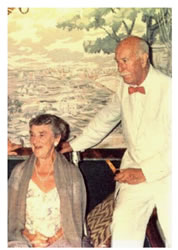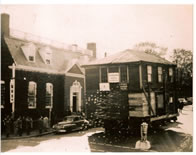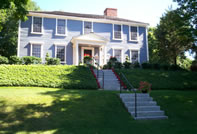
|
|
Hannah Gilbert Palfrey Ayer By Anthony M. Sammarco It was Hannah Ayer who moved and had the Suffolk Resolves House restored in 1950. Once located in Milton Village (the present site of the Citizens Bank) the house was slated for demolition, but her determination to save this historic house and move it to a corner of her estate on Canton Avenue in Milton was to ensure the preservation as what has been called the “Birthplace of the American Revolution.” However, Mrs. Ayer was also a multi faceted woman, known to be dutiful, conscientious, erudite and all that was expected of a woman of her background and this restoration of an historic house created an important contribution and ensuring legacy to local history.
The Palfrey family moved from Belmont to 88 Beacon Street in Boston’s Back Bay and Hannah Palfrey attended Miss Winsor’s School, and later the Garland School of Homemaking. After completing her education, she served as a kindergarten teacher for underprivileged children, and later at the first Montessori School in Boston. Her marriage in 1909 to Dr. James Bourne Ayer (1882-1963), a graduate of Harvard in 1903 and the Harvard Medical School, was an enduring and mutually supportive one. Dr. Ayer was the James Jackson Putnam Professor of Neurology at Harvard Medical School, and Chief of Neurology at Massachusetts General Hospital. He was a practicing physician in Boston and a member of several medical associations, including the Boston Society for Medical Improvement, the Obstetrical Society of Boston, the Massachusetts Medical Society, and the American Medical Society. The Ayers initially lived at 25 Lime Street on the flat of Beacon Hill, but moved to Milton Village when their children were young. At a later date, they purchased a large estate at 1350 Canton Avenue in Milton, where they created impressive gardens that were tended by Dr. Ayer and their gardener Charles Carveth, who with his wife Edith B. Carveth lived in the Suffolk Resolves House. The Ayer house at 1350 Canton Avenue had been built circa 1780 by Dr. John Sprague (1754-1800) who was one of the earliest physicians in Milton, having studied medicine with his father and in Europe. Originally the house was on the present site of the Suffolk Resolves House, but was moved to the crest of the hill by the Eustis Family. The estate had an expansive mansion that had sufficient room for the Ayer Family, as they had six children, Hannah (known as Nancy,) Susannah Cazneau, Mary (known as Molly) Farwell, Elizabeth, James B. Ayer, Jr. and John Palfrey Ayer. Fully supporting her husband in his career, Hannah Ayer was to devote herself to historical pursuits after her children had become adults, becoming a “noted antiquarian and historian” and proud of the fact that her grandfather had served in the American Revolution under Washington. Mrs. Ayer served as the editor of the book A Brief History of Milton Massachusetts and editor in 1950 of A Legacy of New England, Letters of the Palfrey Family. A member of the Massachusetts Historical Society, she served as president of the Milton Historical Society and as a trustee of the Society for the Preservation of New England Antiquities (now Historic New England.) A great club woman, she was a member of the Parliamentary Law Club, the Warren and Prescott Chapter, Daughters of the American Revolution, the Chilton Club and the Nucleus Club.
In this Mansion “Posterity will acknowledge that virtue which preserved them free and happy.” Well, Hannah G. P. Ayer also deserves our accolades and the recognition of her fellow Miltonians, in that she preserved the historic house where the Suffolk Resolves were signed and taken by horseback by Paul Revere to Philadelphia and where they were approved by the Continental Congress.
|

 Hannah Gilbert Palfrey (1888-1963) was the daughter of General John Carver and Adelaide E. Payson Palfrey and was born in Belmont. John C. Palfrey (1833-1906) was a military engineer in the Civil War and a wealthy textile manufacturer in Lowell, Massachusetts. Among her noted ancestors was Colonel William Palfrey, aide-de-camp of George Washington during the Revolution, and paymaster-general of the army; he was appointed consul-general to France, where he was lost at sea sailing to his appointment in 1780. Her grandfather was the Reverend John Gorham Palfrey, a noted Unitarian minister in Boston and author of the History of New England to the Revolutionary War, in five volumes, of which the first appeared in 1859 and the last posthumously in 1890. Rev. Palfrey was minister of the Brattle Square Church from 1818 to 1831, later serving as Professor of Biblical Literature and Dean of Faculty at the Harvard Divinity School.
Hannah Gilbert Palfrey (1888-1963) was the daughter of General John Carver and Adelaide E. Payson Palfrey and was born in Belmont. John C. Palfrey (1833-1906) was a military engineer in the Civil War and a wealthy textile manufacturer in Lowell, Massachusetts. Among her noted ancestors was Colonel William Palfrey, aide-de-camp of George Washington during the Revolution, and paymaster-general of the army; he was appointed consul-general to France, where he was lost at sea sailing to his appointment in 1780. Her grandfather was the Reverend John Gorham Palfrey, a noted Unitarian minister in Boston and author of the History of New England to the Revolutionary War, in five volumes, of which the first appeared in 1859 and the last posthumously in 1890. Rev. Palfrey was minister of the Brattle Square Church from 1818 to 1831, later serving as Professor of Biblical Literature and Dean of Faculty at the Harvard Divinity School. However, it was her interest and determination to save the Suffolk Resolves House that has ensured an enduring legacy. With the assistance of William Morris Hunt II, her “architect-engineer” and fellow board member of the Milton Historical Society, the house was saved from demolition and moved to a corner of her Milton estate where it was restored and made comfortable for her gardener and his wife who lived on the second floor. Mrs. Ayer set about restoring the house to its mid eighteenth century appearance; once two distinct houses, the right part dating from the late 17th century and the left to c.1765, they had been joined in 1785. Hunt placed the historic house on a knoll overlooking Canton Avenue and Mrs. Ayer selected wallpapers and historic paint colors for the interior, taking courses on the painting of fireplace tiles and dyeing crimson her grandmother Palfrey’s enormous damask tablecloths for window swags. A preservationist and knowledgeable decorative arts patron, she studied tile designs at Colonial Williamsburg and painted the Dining Room tiles. She recreated the home of Daniel and Rachel Smith Vose, opening it to schoolchildren and the interested public on special occasions. Upon her death, she bequeathed the Suffolk Resolves House to the Milton Historical Society, which has maintained her vision for almost five decades. The Suffolk Resolves House was placed on the National Register of Historic Places in 1974.
However, it was her interest and determination to save the Suffolk Resolves House that has ensured an enduring legacy. With the assistance of William Morris Hunt II, her “architect-engineer” and fellow board member of the Milton Historical Society, the house was saved from demolition and moved to a corner of her Milton estate where it was restored and made comfortable for her gardener and his wife who lived on the second floor. Mrs. Ayer set about restoring the house to its mid eighteenth century appearance; once two distinct houses, the right part dating from the late 17th century and the left to c.1765, they had been joined in 1785. Hunt placed the historic house on a knoll overlooking Canton Avenue and Mrs. Ayer selected wallpapers and historic paint colors for the interior, taking courses on the painting of fireplace tiles and dyeing crimson her grandmother Palfrey’s enormous damask tablecloths for window swags. A preservationist and knowledgeable decorative arts patron, she studied tile designs at Colonial Williamsburg and painted the Dining Room tiles. She recreated the home of Daniel and Rachel Smith Vose, opening it to schoolchildren and the interested public on special occasions. Upon her death, she bequeathed the Suffolk Resolves House to the Milton Historical Society, which has maintained her vision for almost five decades. The Suffolk Resolves House was placed on the National Register of Historic Places in 1974. As the white marble plaque on the façade of the Suffolk Resolves states:
As the white marble plaque on the façade of the Suffolk Resolves states: